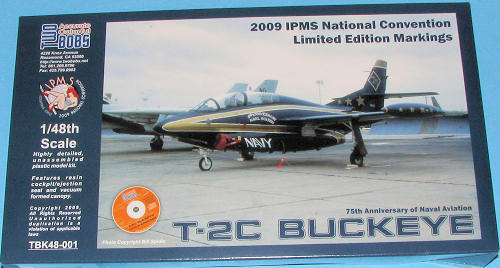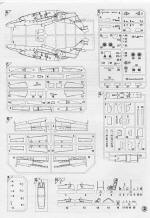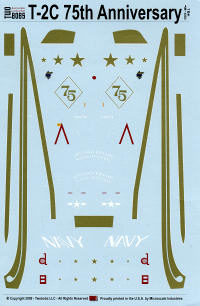
TwoBobs 1/48 T-2C Buckeye
| KIT #: | TBK48-001 |
| PRICE: | $62.50 SRP |
| DECALS: | One option |
| REVIEWER: | Scott Van Aken |
| NOTES: | Limited boxing - 500 kits |

| HISTORY |
The first version of the aircraft entered service in 1959 as the T2J-1. It was re-designated the T-2A in 1962 under the joint aircraft designation system. The two-seat trainer was powered by one Westinghouse J34-WE-46/48 turbojet. The aircraft was subsequently redesigned, and the single engine was replaced with two Pratt & Whitney J60-P-6 turbojets in the T-2B. The T-2C was fitted with two much more powerful 2,950 lbf (13,100 N) thrust General Electric J85-GE-4 turbojets. The T-2D was an export version which was sold to the Venezuelan air force, while the T-2E was sold to the Greek Air Force. The T-2 Buckeye (along with the TF-9J) replaced the T2V-1/T-1A Seastar, though the T-1 would continue in some uses into the 1970s.
The Buckeye was designed as a low-cost multi-stage trainer. Its straight wing is similar to that used in the original North American FJ-1 Fury. Its cockpit controls are similar to the T-28C trainer. The T-2's performance is between that of the Air Force's T-37 Tweet, and the TA-4J Skyhawk. While it has no built-in armament, the T-2 has two underwing hardpoints for .50 in gun pods, 100 lb (45 kg) practice bombs or 2.75 in rockets.
All T-2 Buckeyes were manufactured by North American at Air Force Plant 85, located just south of Port Columbus Airport in Columbus, Ohio. 273 aircraft were built during its production run. The name Buckeye refers to the state tree of Ohio, as well as the mascot of the Ohio State University.
Virtually every Naval aviator from the late 1950's until 2004 received training in the T-2 Buckeye, a career spanning four decades. In the Naval Aviator syllabus, the T-2 has been replaced by the near-sonic T-45 Goshawk (the US Navy version of the BAE Hawk), which is more comparable to other high performance subsonic trainers, or the USAF T-38 Talon. More recently, the T-2 has been used as a director aircraft for aerial drones. Several T-2 Buckeyes are now registered in civilian markings and regularly appear at air shows.
| THE KIT |
 I had learned about this kit while the IPMS/USA 2009 convention was going on in Columbus, so visited the Two Bobs web site only to learn that the standard Buckeye kit was allegedly sold out. With no other option, I bought the special 75th anniversary plane from one of the TraWings in a simple scheme of overall sea blue with gold striping and some stars. I have later come to find out that the standard boxing is easily available now. However, it matters not as everything but the decals are the same.
I had learned about this kit while the IPMS/USA 2009 convention was going on in Columbus, so visited the Two Bobs web site only to learn that the standard Buckeye kit was allegedly sold out. With no other option, I bought the special 75th anniversary plane from one of the TraWings in a simple scheme of overall sea blue with gold striping and some stars. I have later come to find out that the standard boxing is easily available now. However, it matters not as everything but the decals are the same.
The kit is designed by MPM, who, like other short run plastic and resin companies, will be happy to design and produce a kit for you if you have the required funds. It is a great way to get models on your shelf of some of the lesser known or otherwise unkitted planes that have been done. Several brands rely on the services of these companies for their entire product line.
This particular kit is only the second time a T-2 has been offered in injected styrene, the first being, of course, the venerable Matchbox kit in 1/72. This kit is typical of MPM short run kits in that it has nicely done exterior engraving on all the parts. The kit also has a plethora of ejector stubs on one side of all the larger pieces. These will need to be removed in many cases to get the parts to fit. Typically, there are no alignment pins to help out on any of the assemblies.
I was rather taken aback at finding two vacuformed canopies. I would have thought that by now, MPM could have molded these in clear plastic, but apparently the cost was too high or the technology just isn't there to be able to do them. They are very nicely molded and having two gives you the opportunity to screw one up without a major disaster. I find it a bit amusing to note that in the instructions, for the closed canopy option, they show the separate canopy and windscreen. Of course, for this latter option, one will simply not cut the screen and canopy apart.
There is a bag of resin and just about all these bits are to be used in the interior. Resin is used for the side consoles, anti-glare panels, seats and a myriad of other small bits. Only the braces for the inner gear doors and the hinges for the flaps are to be used outside the cockpit. It would have been nice to see the instrument panels done in resin as well for the injected parts are flat and without the usual relief one sees in resin panels.
The kit provides full intake and exhaust trunking that butt up against a bulkhead with the compressor detail. These seem small, but that is because the engines are small. Removing the seams from the trunking will be quite a challenge if one is that concerned about them. All of the control surfaces are separate as well. One can build the aircraft with flaps raised or lowered as they wish. This is one of those modeling head-scratchers. If you look at 100 photos of T-2s on the ground, you'll probably find 100 of them with the flaps up and controls in the neutral position. Since the flight control parts are two pieces anyway, there is no benefit to separate controls.
On the underside of the kit, there is a separate center fuselage section, much like what comes with most Jaguar or A-6 kits. The external intakes are three pieces with the short trunking and forward piece. Care will be needed to remove the center sprue from this intake section. The underside also has a number of small intakes and fairings to be attached.
A-6 kits. The external intakes are three pieces with the short trunking and forward piece. Care will be needed to remove the center sprue from this intake section. The underside also has a number of small intakes and fairings to be attached.
The landing gear is well done with wheels in two halves. I found the wheels to be somewhat 'flat' in that they have little depth to them. This is an area where resin would have been useful. The main gear strut is two pieces; one lower with the bracing and an upper section that glues to it. It would have been nice to have this as a single piece. Same with the oleo scissors, which are two pieces each. Some trimming is needed to fit the main gear and one will have to make some bits out of plastic rod, but the instructions show just how this is to be done (in millimeters). There is a clear sprue with anti-collision lights and wing tank tips.
Instructions are typical MPM with no color information listed during the build. I find this quite irritating as I know the interior and seats are not bare plastic/resin. Even the separate decal and painting guide has no information in this regard. To compensate for that, there is a CD included with 300 images in it from which you can glean color information. I should mention that most of the detail images are from display planes or war birds so may not be 100% accurate in regards to how the planes appeared in service. The decals are printed by Microscale, are well done, and in register.
| CONCLUSIONS |
I'm sure there are many such as I who are pleased to see a 1/48 Buckeye that isn't vacuform or resin. Just looking through things tells me that it won't be a quick build, but you have everything you need to produce a fine replica of this most widely used Naval trainer. As a final note, I wonder why Two Bobs picked a substandard box art photo from an air show and on a cloudy day. Perhaps it is to show the red rimmed inner gear doors and the under wing placement of the gold stripe.
| REFERENCES |
January 2010
Thanks to me for this one.
If you would like your product reviewed fairly and fairly quickly, please contact the editor or see other details in the